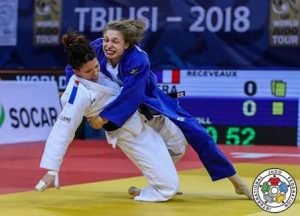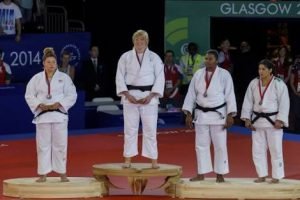
The one of the important game in history is judo. It is played like martial arts of hand to hand fighting, throws to the ground. It increases our mental and physical capability strong. Today we will discuss about the Judo: History, Rules, Play Field, Fundamental Skills, Terminology
Judo: History, Rules, Play Field, Fundamental Skills, Terminology

History of Judo
It is a Japanese word which means “the gentle way”. This unarmed style of fighting is designed from other material arts of hand to hand fighting, throws to the ground, etc. Japan’s Jigoro kano, designed this game for the physical and moral development of its practitioners. The underlying principle of Judo is that the judoka never resists his opponent’s force, rather turns it back on his attacker. Judo is a defensive art, a spectator sport, and a competitive sport. Judo first appeared in the Olympic Games at Tokyo in 1964, but was officially admitted as a men’s sport at the Munich Olympic Games (1972). Men participated in their first world championship in Tokyo (1956), the first women’s World Championship was held in 1980 in New York. Women’s judo became an Olympic event in 1992 in Barcelona. Judo is controlled by ‘International Judo Federation’ (IJF). Now, it is played in India.
Rules of Judo

Following are the main rules of judo:
- They bow to each other before moving to the tatami ( place of fight over mats ) and position themselves on the marks corresponding to the colour of their judogi, and bow again.
- The judoka meaning wears a blue judogi and white judogi.
- The refree starts the fight with the word “Hajime”. The competitors bow to each other again.
- A fight ends when a competitor scores an Ippon (10 points) or when the time limit expires (5 minutes for men and 4 minutes for women)
- Random draws determine the contestants for each fight. The judoka’s player who loses a fight is eliminated.
- Penalty are also counted which declines the score, like Shido, Chui, Keikoku, Honsokumake.
- If an Ippon is not scored, the judoka with the higher points wins the match. Ippon, waza-ari, yuko, koka, matte are the basic elements of judo.
Play Field Of Judo

Judo playground is called shiajo. It is a square platform covered with matting. Its each side is 30 feet. This platform is at some height from the ground. It is covered with 50 mats pieces of canvas. Each piece is of the size of 1*2 mts.

Officials
- There are normally three officials to conduct judo bout. One of them is a refree and the other two are judges.
- Bout is arranged by a refree. Decision of judo Bout is given by two- third majority.
- If both the judges are not agree with the decision of the refree then they can ask the refree to change his decision.
- Two-Thirds majority can be of one refree and one judge or both the judges.
Costume
- The clothes worn by judo players are called Judogi.
- Judogi consists of one jacket, trousers fitted at the waist and one belt.
- In case judogi is not available, a player can wear a dress, the belt of which is of the length to cover the body twice
- After a square knot is tied, 20-30cm belt on each side should be left. The jacket should also be so long that it covers the hips after being tied with a belt. Its arms should be wide.
Fundamental Skills Of Judo
1. Ready position: The combatant ties to grab his opponent quickly and throws him off balance.
2. Gfipping: The judoka who sucessfully grabs his opponent (1 curmkata) has the advantage.
3. Positioning: The seized combatant tries to escape from the kumi kata, while his attacker prepares the next throw.
4. Throwing: After throwing his opponent off the balance, thereby depriving him of his powers of self-defence.
Terminology Of Judo

1. Koka: A controlled throw to the opponent on his shoulder, for 10 seconds hold. It give 3 points.
2. Honsokumake: Penalty of 10 points which make opponent as winner of bout. It is a serious intentional hurting to opponent against the rules of the game.
3. Ippon: There are three ways to score an Ippon:
A. By throwing the opponent to his back with control force and speed.
B. This forces the opponent to submit.
C. Using an arm lock or choking technique for 25 seconds. Player get 10 points and wins the boult.
4. Keik-oku: Penalty of 7 points where player disobeys the match Refree decision or trying to hurt opponent against rukes of the game.
5. Maltt: To interrupt the fight, the refree calls for “Matte”. The contestants must separate and return to their respective marks.
6. Shido: It is a penalty of 3 points where opponent player is hurt unintentionally, delays to follow the match Refree’s decision especially ‘matte’
7. Vlaza-Ari: A controlled throw to the opponent using a technique, for 20 seconds hold. It gives 7 points lead.
8. Yuko: A controlled throw using a technique (missing 2 of the 4 elements) for 15 seconds. It gives 5 points.
karate
| Focus | Wrestling, grappling |
|---|---|
| Hardness | Full contact |
| Country of origin | |
| Creator | Kanō Jigorō |
| Famous practitioners | See: List of judoka |
| Parenthood | Various koryū Jujutsuschools, principally Tenjin Shin’yō-ryū , and Kitō-ryū |
| Ancestor arts |
|
| Descendant arts | Kosen judo, Bartitsu, Yoseikan Budō, Brazilian jiu-jitsu, Sambo, ARB, CQC, Krav Maga, Kapap, Hapkido, Kūdō, modern Arnis, Luta Livre, Catch wrestling, Shoot wrestling, Submission wrestling, Vale tudo |
| Olympic sport | Since 1964[1] (men) and 1992[2] (women) |
| Also known as | Karate Do (空手道) |
|---|---|
| Focus | Striking |
| Hardness | Full-contact, semi-contact, light-contact |
| Country of origin | Ryukyu Kingdom |
| Parenthood | Indigenous martial arts of Ryukyu Islands, Chinese martial arts[1][2] |
| Olympic sport | Will debut in 2020 |
You can Also read our latest articles. I hope you should like the article. Subscribe for latest Articles
| Also known as | TKD, Tae Kwon Do, Tae Kwon-Do, Taekwon-Do, Tae-Kwon-Do |
|---|---|
| Focus | Striking, kicking |
| Hardness | Full-contact (WT), Light and medium-contact (ITF, GTF, ATA, TI, TAGB) |
| Country of origin | Korea |
| Parenthood | Mainly Taekkyon and Shotokan Karate. Slight influence of Chinese martial arts[1] |
| Olympic sport | Since 2000 (World Taekwondo) |
